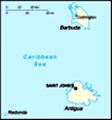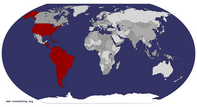Advertisement
Published: March 17th 2017
Today we were in Antigua, as in Antigua and Barbuda. This is our 3
rdCaribbean island and there is one more tomorrow. Barbuda is a small nearby island, but we did not go there and we only learned a little about it, so we will only talk about Antigua today.
We got up a little earlier than yesterday because we need to be in the theater 15 minutes earlier than yesterday. David got us our usual “morning excursion breakfast” and we headed off to our tour at 8:00. The same leader was there as yesterday and he let us stay at the top of the theater and ride the elevator rather than walking the stairs. There were 3 cruise ships in port today and it took a little while before they let any of us go ashore. We were some of the first ones and we got in the front of the line for buses. Here they have pretty narrow roads so the bus is smaller than usual – probably about 25 people max.
We boarded bus #1 with some other people who had mobility problems. Throughout the day, the driver Tony (with the pony, as
in ponytail) and our guide named Angela, tried to get the bus as close as possible to the drop of places to minimize our walking. There were 4 locations where we had short excursions but in the meantime we were given lot of information about Antigua.
The island is divided into 6 parishes, all named for saints. There are 52 towns of villages and the capitol St Johns is the only large one we saw today. There are 95,000 residents on the island and it is 108 square miles. Only 45% of the residents are considered original inhabitants (including the slaves imported from Africa), with the remainder being from many places around the world. The cruise season only runs from November thru April, but the international airport enables tourists to visit year round. Tourism is their #1 source of revenue, followed by the export of rum. They are always searching for foreign investment to bring more money to the island.
Back in 1493 Columbus discovered Antigua but it was without water and nothing was growing here. He did not bother to explore it and declared it to be of no interest. Eventually in 1632,
the English came and established a settlement. They divided all the land into 161 large plantations and sold them to wealthy people back in England. Life was very difficult here and they had to work hard to make anything grow. Initial crops of Cotton and Tobacco were not sufficiently profitable, so they switched crops to sugarcane. Slaves were brought from Africa and eventually Antigua became the #1 sugarcane producer in the world. Somehow the leaves of the sugarcane plants caused moisture to accumulate and rainfall was approximately 45 inches a year. They had built complex water collection systems and performed significant irrigation to grow their crops. Once slavery was abolished sugarcane became unprofitable and the island has dramatically reduced the amount that is grown. In doing so, the rainfall has significantly reduced and the last 10 years, Angela said the annual rainfall was only 1-2 inches per year. We do not understand how the cane leaves could affect the amount of rainfall, but that’s the story. In any case the island now works very hard to capture water through run-off containers, whatever rain that does fall and they have a desalinization plant to produce more drinking water.
The ship is docked in the harbor on the Caribbean side of the island. All the stops on our excursion were over on the Atlantic side. Apparently the prevailing winds off the Atlantic causes some cloud formation as the weather rises up the hillsides, but the result is that we had some cloudy times, including a few sprinkles. Having heard how little rain they get here, we actually had a smidgen today. But mostly it made the pictures less bright.
Our first stop was at Dow’s Hill. This is a high point which overlooks a large part of the coastline here. Our guide gave a description of the harbors and forts which could be seen from here. There were originally 40 forts which protected these English islands from invaders and/or pirates. From the high points there is a lookout who would raise a large flag when he spotted enemy ships. Nearby fortifications would see the flag and be prepared, but they would also forward the message to neighboring forts by raising their own flag. In that way the island had a complete alert system and was never successfully invaded. Anyway, after an outdoor tour we attended a
15 minute show which gave a quick summary of the island’s history. It was very interesting.
The second stop was a short distance away at Fort Blockhouse. This was out on a peninsula with a commanding view of the coast, so the British cannons could fire down on ships long before they could assault the island. Some of the old structures were still in place, but many were basically just ruins. However there was one stone section which drained to a cistern for collecting water, and that still works even today. This was a short stop, mostly for the view which unfortunately was impacted by the clouds.
The third stop was at Shirley’s Height Lookout. This was another promontory which overlooked Nelson’s Dockyard. From here you could look down into the ay and see the development which has occurred in recent times. In the old days, you could see two forts (one on either side of the harbor entrance) where a heavy chain boom was floated between them to keep unwanted ships from entering. Only if it was a “good ship” would the boom be moved and the passage cleared.
The
final stop was down at Nelson’s Dockyard itself. This is the best preserved (maybe refurbished) of the structures. It was a major value to the English for several reasons. One it was a key harbor for ships to use. Two, it had the only careening facilities between here and London. That means they had the equipment to basically pull a ship out of the water, tilt it on one side, and scrape the barnacles off the bottom of the ship. Then the other side of the ship was cleaned in the same manner and finally the ship was refloated. Three, this was the headquarters where Sir Horatio Nelson administered the island for a period of time – that’s why it was named Nelson’s Dockyard.
At the conclusion of this 4
th visit we were given a glass of rum punch and had time to do some shopping. Angela gave us a loose description of the recipe but without specific measurements. We know what goes into the punch, we just have to experiment with the quantities to get the desired flavor/strength.
We drove back to St Johns and returned to the ship. Angela gave us a
lot of additional information about Antigua but we cannot get it all into the blog right now. We had a little walk back to the ship and then went to the Horizon Court for lunch. It was a little after 1:00 so we were hungry and thirsty. We finished lunch with some Peach Crisp with ice cream.
Back in the cabin, Janet settled down to rest her leg, which was hurting after the walking today. One of the problems we had was that almost always the bus was stopped on an uphill slant which made it even harder to get out of the crowded seats and climb out of the bus. So she decided to go ahead and take a nap. David took the camera up on deck to try to take a few local pictures around the ship. Then he went to the pool for an hour and got some sun. It was a comfortable temperature today – probably in the low 80s.
About 4:00 we did some internet stuff down in the Internet Center and then Janet got a Salted Carmel Strata Coffee. At 5:00 we had changed for dinner and we
went to chat with Debbie and Craig about our excursions. They had gone on a snorkeling trip where they swam with some stingrays along a reef. They had a lot of fun but had not heard all the information we learned from Angela. Then at 5:45 we went on to Dinner. Along the way we encountered Jim’s friend (Rich) but we were getting into the elevator and did not chat with him.
For dinner Janet had the Caesar Salad and a special Spaghetti Pasta in Olive Oil which the head waiter was preparing. David had the chilled blackberry merlot soup, and a sample of the pasta, and an entrée of shrimp & scallops casserole. Once again we had a delicious dinner. There is a comedian in the theater this evening which David might go to later, after the blog is sent. Janet has settled in for the evening. We have an afternoon excursion tomorrow, so we plan to sleep later in the morning.
For the third day in a row we had a very enjoyable time on one of the Caribbean Islands. We were given a number of items of literature about Antigua, with
even more information. There are supposed to be 365 sandy beaches on the islands but we didn’t really deal with any of them. That’s about all for tonight.
Advertisement
Tot: 0.132s; Tpl: 0.012s; cc: 6; qc: 44; dbt: 0.0515s; 1; m:domysql w:travelblog (10.17.0.13); sld: 2;
; mem: 1.1mb








